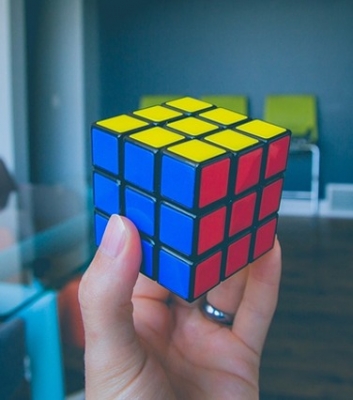
The Rubik’s Cube, a 1974 invention of Ern? Rubik of Hungary, fascinated people around the globe and became one of the most popular games in America in the early 1980s, having been initially released as the Magic Cube in Hungary in late 1977, and then re-manufactured and released in the western world as Rubik’s Cube in 1980.
The invention, eventually renamed the Rubik’s Cube, would become the most popular puzzle toy in the world, with more than 350 million sold as of 2018. The cube also inspired numerous artworks and films, and spawned a competitive sport called speedcubing that fills arenas with teenagers racing to complete the puzzle in the shortest amount of time.
At first glance, the cube seems deceptively simple, featuring nine colored squares on each side. In its starting state, each side has a uniform color — red, green, yellow, orange, blue, or white. To solve the puzzle, you must twist the cubes so that eventually each side returns to its original color: The challenge is the astounding number of potential variations — more than 43 quintillion of them.
To master the cube, you must learn a sequence of movements that can be performed in successive order — the subject of several best-selling books as well as online tutorials. And the evolution of the cube — from a three-by-three-by-three shape to larger four-by-four-by-four and five-by-five-by-five ones — offers different complicated mathematical principles of group theory.
Rubik initially believed the cube would appeal to those with science, math, or engineering backgrounds — and was shocked when “it found its way to people whom nobody would ever have thought might be attracted to it,” he writes.
In March 1981, the Cube landed on the cover of Scientific American, where Pulitzer-Prize winning scientist Douglas Hofstadter, author of “Gödel, Escher, Bach” (1979), called it “one of the most amazing things ever invented for teaching mathematical ideas.”
The cube struck Hofstadter as “paradoxical,” he said in a phone interview, since it can be used as a tool to teach group theory, or the symmetries of objects. “Any twist of any face (clockwise 90 degrees, counterclockwise 90 degrees, or 180 degrees) is a group element, and so are arbitrary sequences of such twists,” he later explained by email.
Sitting on the patio of his home in the hills of Budapest, Rubik, now 76, fiddled with a cube as he recalled its “discovery” and accidental success. (He prefers to use “discovered,” rather than “invented” — as if the existence of the object was somehow pre-ordained).
Credit : Smithsonian
Picture Credit : Google




